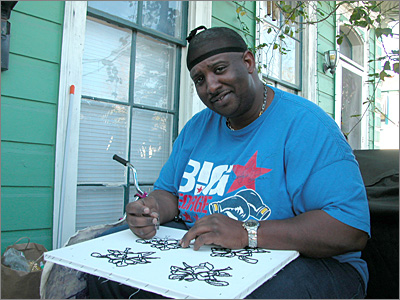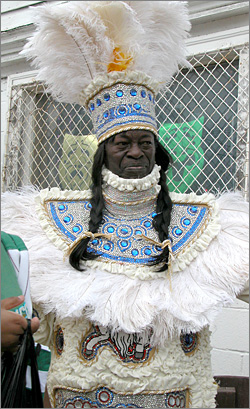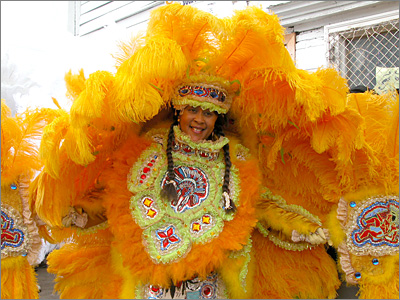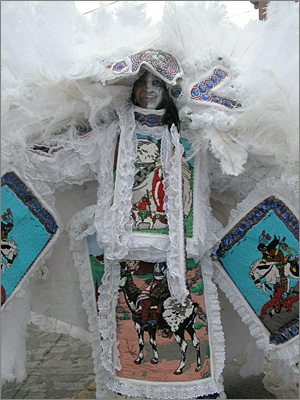
Gerald French, a member of the Wild Magnolias, beads a patch for the Indian suit he plans to wear for Jazzfest. - photo by Kate Ellis

Fourth generation New Orleans musician dedicated to preserving the culture and art of the Mardi Gras Indians.
Gerald French is a Mardi Gras Indian. He rolls with a tribe called the Wild Magnolias. Mardi Gras Indians come from primarily black and Creole neighborhoods in New Orleans. On Mardi Gras day they dress head-to-toe in elaborate, beaded costumes that erupt in a spray of brightly colored feathers, and parade through the back streets of the city. It's called masking Indian, and it's a tradition that goes back some 150 years.
French is a big bear of a man. He's 37 and often covers his bald head with a black do rag. He's a drummer by profession, the fourth generation in his family to make music for a living. His uncle is the legendary traditional jazz drummer, Bob French; another uncle played trombone with Louis Armstrong. "So when it comes to New Orleans history," French says, "I'm a poster child."
Despite this musical lineage, French has a different true love. "I have responsibilities and I have things I need to do, but my passion is dressing as a Mardi Gras Indian."
On Mardi Gras days, tribes or gangs of Indians play out imaginary duels, not with weapons, but with regalia. "When they meet at a crossroads, they may battle it out for who's the prettiest, and who should pass first," explains Nick Spitzer, host of the radio program American Routes. Spitzer is an anthropologist who's studied Louisiana culture for decades. "In the old days," he says, "they might have fought at the crossroads, but now they just fight with their costumes."

Singer Bo Dollis, Big Chief of the Wild Magnolias, decked out for Mardi Gras 2007. - photo by Kate Ellis
New Orleans has about two dozen Indian tribes, with names like Yellow Pocahantas, Fi Yi Yi, and Morning Star Hunters. Each one is headed by a big chief, with a crew of six to eight other people to protect him when the tribe is marching.
When the Indians march they spread themselves out over several blocks. There's a spy boy out front directing signals up the line. Gerald French is the flag boy for the Wild Magnolias. His job is to convey signals from the big chief to the rest of the crew with an enormous flag.
Normally French would be decked out in his own costume, but on the second Mardi Gras after Katrina, he wore old jeans and a baggy black T-shirt. The Indian suit he'd been making got destroyed in the flood, along with everything else he owned.
"We got wiped clean," he says. So French had to sit out the last two Mardi Gras parades. But he adds, "I've been sewing the whole time."
French spent his youth learning music. But he couldn't wait to mask Indian. It took French two years to sew his first costume and he says it was well worth the time. "When I have my suit on," he explains, "I feel like I'm invincible. Because I sewed this. I took the time to create this. This is an extension of me and it fulfills me to sit here and do this."
French holds up a canvas panel he's embroidering with tiny glass beads. He's sewing them into the shape of a magnolia. He plans to wear this suit at Jazzfest, a massive music and culture festival that takes place in New Orleans every spring. French looks at the panel thoughtfully and explains, "I'm coming up with a weird color scheme. I'm trying to see if I can pull it off-charcoal grey and fuchsia-hot pink."
Indians spend months hand-beading their regalia for Mardi Gras day. The feathers and beads and other materials for a well-made Indian costume can run many thousands of dollars. The hard-core traditionalists make a new costume every year.

Laurita "Big Queen Rita" Barras, of the Wild Magnolias, Mardi Gras 2007. - photo by Kate Ellis
Most Mardi Gras Indians are men. So it's mostly men who do the sewing. If you can't sew, you can't mask, says Sylvester Francis, a self-taught local expert on Indian traditions. Sewing time is often a social time, a chance to talk, drink beer and eat - the male equivalent of a quilting bee.
"Guys sit around a table and sew all day and all night," Francis explains. If Indians see each other out on the street, Francis says, one will ask, "Brother, you been sewing?" The other will respond, "Yeah, I'm gonna be heavy." That means the Indian is still adding beads and rhinestones to his costume.
The catastrophic flood that followed Hurricane Katrina swept away many poor and working class black neighborhoods in New Orleans, places where much of the city's authentic Afro-Creole culture springs from. Two years after the storm, many of those neighborhoods are still empty. So what happens to the music, the food traditions, the architecture, the street parades when people aren't around to share them? In the case of Mardi Gras Indians, it depends on who you ask.
French says that before the disaster, masking Indian was a priority. Now that's harder. "Because of Katrina, a lot of gangs were kind of short this year," French says. "A lot of guys moved away and started new lives. It's hard for them to get back. And for the guys that are here, financially, times are just tough. The money that they would use to make a costume, they have to use to redo the roof or put new floors down. You got to survive."

Gerald French carries a head piece he sewed for one of the Wild Magnolias on Mardi Gras. - photo by Kate Ellis
For Gerald French and his wife, survival meant scrapping pre-storm plans to buy their first house. They spent their savings evacuating to Shreveport and living there for a year. Now they rent a small place in the mid-city neighborhood of New Orleans and live out of suitcases.
For French, that's a vast improvement. "Some people look at New Orleans and say it's a Third World country," he says, adding, "I think we should be our own country. There's no place in the world like it. In other towns you go to work, you go home, you go to sleep. There's nothing else to do!" French is laughing now. "I mean, there's more to life than cutting grass."
French is hoping his family will be able to purchase a small home in Musicians Village, a new community in the upper Ninth Ward built by Habitat for Humanity. For many New Orleans residents, finding any place affordable is tough these days. The flood wiped out most of the city's low-income housing. It will take years to build it back.
That has Sylvester Francis worried. Many of the Mardi Gras Indians came from public housing projects and the poor, low-lying communities surrounding them. Those people are now scattered around the country. For now, members of Mardi Gras gangs trek back to New Orleans to mask. But for how long?
"People gonna get tired," Francis says. "If you know your club is going to parade on July the Fourth -- you coming down. Because you gonna parade Sunday. But all that's going to die out."
Sylvester Francis founded the "Backstreet Museum," a small establishment in the Treme neighborhood dedicated to the carnival traditions of downtown black and Afro-Creole people. One room is lined on all four walls with Mardi Gras Indian costumes and photographs. The other room displays the extravagant suits and paraphernalia of social aid and pleasure clubs.

Gerard Dollis, son of singer Bo, shows off his hand-beaded suit for Mardi Gras. - photo by Kate Ellis
Francis has an oval face softened by age and a few missing teeth. He walks with a limp. A former funeral home employee, he's been photographing and filming the performance culture of back street New Orleans - jazz funerals, Mardi Gras Indian processions and second line parades - for some 30 years. In 1999 he converted the historic Blandin funeral home into a two-room museum. Giving a tour of the museum, Francis says, "All the culture people is black." With the projects closed, Francis laments, "The culture people is not there. We need them projects."
Gerald French is not so sure. By his reckoning, it's the distinct New Orleans culture Francis has so richly documented in the Backstreet Museum that will lure the "culture people" back.
"I know guys as far away as Arizona that get on the Internet to get their beads," French says. For now, they live away from the city and save their money to come back and parade. Eventually, French believes, a lot of them will come back for good.
"People want to come home," he says.
And New Orleans wants the Mardi Gras Indians home, too. Just ask Gerald French. "I just think that the Indians signify a ray of hope. There is beauty here in the city, something other than crooked politicians and gunshots when you come to New Orleans. What we do is considered visual art. But I don't consider it just that. I think of it as being a symbol of pride for the neighborhoods we represent," he says.
Gerald French is an optimist. But even that mindset, he believes, is part of the New Orleans culture. "I don't know any other people who can take so little and make so much out of it," he says. "This always has been a poor man's kind of town. It's part of the soul, the funk of New Orleans."
More from Routes to Recovery
| 
